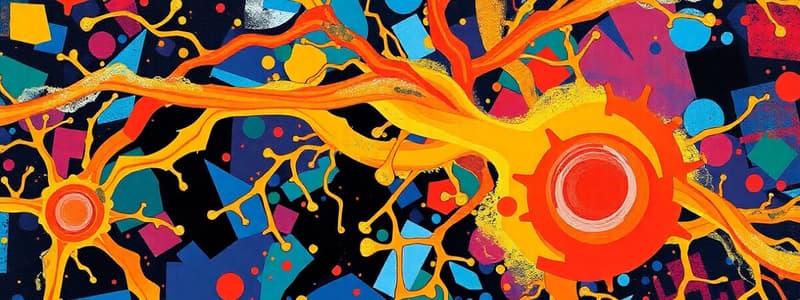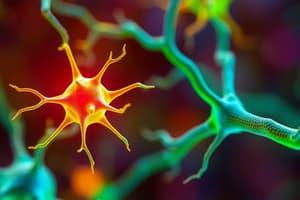Podcast
Questions and Answers
What type of summation occurs when graded potentials arrive simultaneously from different synapses?
What type of summation occurs when graded potentials arrive simultaneously from different synapses?
- Spatial summation (correct)
- Convergent summation
- Temporal summation
- Dendritic summation
Which statement about EPSPs is correct?
Which statement about EPSPs is correct?
- EPSPs have a specific threshold that must be reached.
- EPSPs can only occur when the membrane is hyperpolarized.
- EPSPs are graded in magnitude and can summate. (correct)
- EPSPs cause an efflux of K+ ions.
Which of the following ions primarily causes hyperpolarization in postsynaptic inhibition?
Which of the following ions primarily causes hyperpolarization in postsynaptic inhibition?
- K+ influx
- Cl- influx (correct)
- Na+ influx
- Ca2+ influx
What is the primary role of calmodulin in neurotransmitter release?
What is the primary role of calmodulin in neurotransmitter release?
What role does presynaptic inhibition play in neurotransmitter release?
What role does presynaptic inhibition play in neurotransmitter release?
What is the primary mechanism of neurotransmitter release from a presynaptic neuron?
What is the primary mechanism of neurotransmitter release from a presynaptic neuron?
Which of the following statements about temporal summation is true?
Which of the following statements about temporal summation is true?
Which type of channel opens during an excitatory postsynaptic potential (EPSP)?
Which type of channel opens during an excitatory postsynaptic potential (EPSP)?
What role do gap junctions play in electrical synapses?
What role do gap junctions play in electrical synapses?
If the membrane potential in a postsynaptic cell reaches the threshold at the axon hillock, what occurs next?
If the membrane potential in a postsynaptic cell reaches the threshold at the axon hillock, what occurs next?
Which of the following best describes the synaptic cleft?
Which of the following best describes the synaptic cleft?
Which of the following is a function of substance P?
Which of the following is a function of substance P?
How does the amount of neurotransmitter released at the synaptic cleft vary?
How does the amount of neurotransmitter released at the synaptic cleft vary?
What is the effect of an inhibitory postsynaptic potential (IPSP) on the postsynaptic membrane?
What is the effect of an inhibitory postsynaptic potential (IPSP) on the postsynaptic membrane?
Which statement correctly distinguishes between EPSP and IPSP?
Which statement correctly distinguishes between EPSP and IPSP?
What is the primary function of acetylcholine (ACh) at neuromuscular junctions?
What is the primary function of acetylcholine (ACh) at neuromuscular junctions?
What effect does a muscarinic ACh channel have on postsynaptic cells?
What effect does a muscarinic ACh channel have on postsynaptic cells?
What is true about the structure of nicotinic ACh channels?
What is true about the structure of nicotinic ACh channels?
Which statement about Acetylcholinesterase (AChE) is accurate?
Which statement about Acetylcholinesterase (AChE) is accurate?
What is the significance of convergence in neuronal pools?
What is the significance of convergence in neuronal pools?
Flashcards
Synapse
Synapse
A functional connection between a presynaptic neuron and a postsynaptic cell.
Electrical Synapse
Electrical Synapse
A type of synapse that allows direct current flow between cells through gap junctions.
Chemical Synapse
Chemical Synapse
A synapse where neurotransmitters are released to communicate between cells.
Excitatory Postsynaptic Potential (EPSP)
Excitatory Postsynaptic Potential (EPSP)
Signup and view all the flashcards
Inhibitory Postsynaptic Potential (IPSP)
Inhibitory Postsynaptic Potential (IPSP)
Signup and view all the flashcards
Calmodulin activation
Calmodulin activation
Signup and view all the flashcards
Neurotransmitter release (NT release)
Neurotransmitter release (NT release)
Signup and view all the flashcards
EPSPs and IPSPs
EPSPs and IPSPs
Signup and view all the flashcards
Axon hillock
Axon hillock
Signup and view all the flashcards
Neuropeptides
Neuropeptides
Signup and view all the flashcards
Corticospinal Pathway
Corticospinal Pathway
Signup and view all the flashcards
Summation
Summation
Signup and view all the flashcards
Temporal Summation
Temporal Summation
Signup and view all the flashcards
Spatial Summation
Spatial Summation
Signup and view all the flashcards
Postsynaptic Inhibition
Postsynaptic Inhibition
Signup and view all the flashcards
Acetylcholine (ACh)
Acetylcholine (ACh)
Signup and view all the flashcards
Nicotinic ACh Channel
Nicotinic ACh Channel
Signup and view all the flashcards
Muscarinic ACh Channel
Muscarinic ACh Channel
Signup and view all the flashcards
Acetylcholinesterase (AChE)
Acetylcholinesterase (AChE)
Signup and view all the flashcards
Integration of Signals
Integration of Signals
Signup and view all the flashcards
Study Notes
Synaptic Transmission
- Synapse is a functional connection between a neuron (presynaptic) and another cell (postsynaptic)
- Electrical and chemical synapses exist
- Electrical synapses are rare in the nervous system
- Synaptic transmission at chemical synapses occurs via neurotransmitters (NTs)
Learning Objectives
- Compare convergence and divergence in neural arrangement and understand their significance
- Describe the transmission of impulses at the synapse
- Distinguish excitatory (EPSP) and inhibitory (IPSP) postsynaptic potentials
Synapse = Cell-to-Cell Conduction
- A functional connection between a neuron (presynaptic) and another cell (postsynaptic)
- Electrical and chemical synapses exist
- Electrical synapses are rare in the nervous system
- Synaptic transmission at chemical synapses is via neurotransmitters
Electrical Synapse
- Depolarization flows from presynaptic to postsynaptic cell through channels called gap junctions
- Formed by connexin proteins
- Very fast conduction
- Found in smooth and cardiac muscles, brain, and glial cells
Chemical Synapse
- Synaptic cleft separates terminal bouton of presynaptic from postsynaptic cell
- Pre-synaptic terminal releases neurotransmitters
- Synthesis of neurotransmitters
- Ca²⁺ influx triggers release of neurotransmitters
- NTs are in synaptic vesicles
- Vesicles fuse with bouton membrane, releasing NT by exocytosis
- Neurotransmitter diffuses across synaptic cleft
- Amount of NT released depends upon frequency of AP
- Postsynaptic cell has specific receptors for the neurotransmitter
Synaptic Transmission 1
- Presynaptic neuron brings impulse to the synapse to stimulate or inhibit a postsynaptic neuron
- This is synaptic transmission
- Action potentials travel down the axon to depolarize the bouton
- Voltage-gated Ca²⁺ channels open; Ca²⁺ diffuses inward
- Triggers exocytosis of vesicles, releasing NTs
- First activating calmodulin, then protein kinase
- Phosphorylating regulatory proteins promotes vesicle fusion and exocytosis
- NT release is rapid because vesicles are docked at release sites before APs arrive
- Neurotransmitters diffuse across the synaptic cleft, binding to specific receptors
Synaptic Transmission 2
- NT (ligand) diffuses across cleft
- Binds to receptor proteins on postsynaptic membrane
- Opening chemically-regulated ion channels
- Depolarizing membrane causes EPSPs (excitatory postsynaptic potentials)
- Hyperpolarizing membrane causes IPSPs (inhibitory postsynaptic potentials)
- These are graded potentials
Synaptic Transmission 3
- EPSPs and IPSPs summate
- If membrane potential (MP) in postsynaptic cell reaches threshold at axon hillock, a new action potential (AP) is generated
- Axon hillock has many voltage-gated channels and is where APs are initiated
Synaptic Transmission 4
- Action potentials are conducted by axons
- Opens voltage-gated Ca²⁺ channels
- Release of excitatory neurotransmitters
- Opens chemically gated channels
- Inward Na⁺ diffusion causes depolarization (EPSP)
- Localized, decremental conduction of EPSP
- Opens voltage-gated Na⁺ and then K⁺ channels
- Conduction of action potentials
Synaptic Potentials
- Synaptic potentials are graded and can depolarize or hyperpolarize the receiving cell membrane
- EPSP (excitatory postsynaptic potential) opens Na⁺ channels, depolarizing the membrane
- IPSP (inhibitory postsynaptic potential) opens K⁺ channels, hyperpolarizing the membrane
Synaptic Inhibition
- Presynaptic inhibition: one neuron synapses onto axon or bouton, inhibiting release of another neuron's neurotransmitter
- Postsynaptic inhibition: GABA and glycine produce IPSPs, dampening EPSPs, making it harder to reach threshold
- K⁺ efflux or Cl⁻ influx causes hyperpolarization
Neurotransmitters
- Acetylcholine (ACh): autonomic ganglion, stimulates muscle contractions
- Monoamines: norepinephrine, epinephrine, dopamine, serotonin
- Amino acids: glycine, glutamic acid, GABA
- Peptides: enkephalins, substance P
Neuropeptides
- Neurons in the CNS synthesize neuropeptides
- Act as neurotransmitters or neuromodulators
- Enkephalins bind to opiate receptors, relieving pain
- Beta-endorphin binds to opiate receptors, lasting longer
- Substance P helps perceive pain
Major Neurotransmitters
- Acetylcholine is a major neurotransmitter in the peripheral nervous system
Acetylcholine (ACh)
- Most widely used NT
- Used in brain and ANS, used at all neuromuscular junctions
- Has nicotinic and muscarinic receptor subtypes
- These can be excitatory or inhibitory
Ligand-Gated Channels
- Contain both a NT receptor site and an ion channel
- Open when ligand (NT) binds to its receptors
Nicotinic ACh Channel
- Formed by 5 polypeptide subunits
- 2 subunits contain ACh binding sites
- Opens permitting diffusion of Na⁺ and K⁺
- Inward flow of Na⁺ dominates, producing EPSPs
G Protein-Coupled Channels
- NT receptor is not part of the ion channel
- Is a 1 subunit membrane polypeptide
- Activates ion channel indirectly through G-proteins
Muscarinic ACh Channel
- Binding of 1 ACh activates G-protein cascade, affecting gated K⁺ channels
- Opens some, causing hyperpolarization
- Closes others, causing depolarization
Acetylcholinesterase (AChE)
- Inactivates ACh, terminating its action; located in the cleft
Integration of Signals
- Interneurons are organized into neuronal pools (groups of neurons that work together)
- Convergence: a single neuron receives impulses from two or more fibers; allows collection and processing of information
- Divergence: an impulse from one neuron stimulates two or more fibers, amplifying response
Convergent Pathway
- Many presynaptic neurons converge to influence a smaller number of postsynaptic neurons
Divergent Pathway
- One presynaptic neuron branches to affect a larger number of postsynaptic neurons
Summation: Convergent Integration
- Graded potentials are below threshold
- Graded potentials arrive at the trigger zone, summating to create an AP
- Spatial summation
- Temporal summation
- Summation can be EPSP or IPSP
EPSP
- Graded in magnitude
- Have no threshold
- Na⁺ or Ca²⁺ influx causes depolarization
- Summate
- Have no refractory period
Temporal Summation
- EPSPs fade quickly but closely-timed EPSPs sum before they fade
Spatial Summation
- EPSPs fade quickly over time and distance
- EPSPs from different synapses occur in postsynaptic cell at the same time
Postsynaptic Inhibition
- GABA and glycine produce IPSPs
- IPSPs dampen EPSPs, making it harder to reach threshold
- Presynaptic inhibition: one neuron synapses onto an axon or bouton, inhibiting the release of a neuron's neurotransmitter
- K⁺ efflux or Cl⁻ influx causes hyperpolarization
Studying That Suits You
Use AI to generate personalized quizzes and flashcards to suit your learning preferences.




